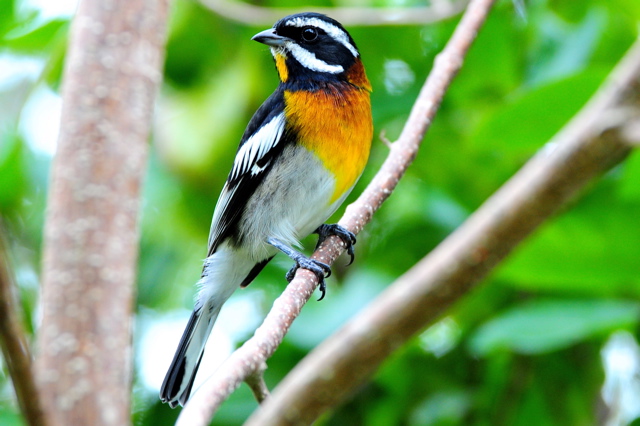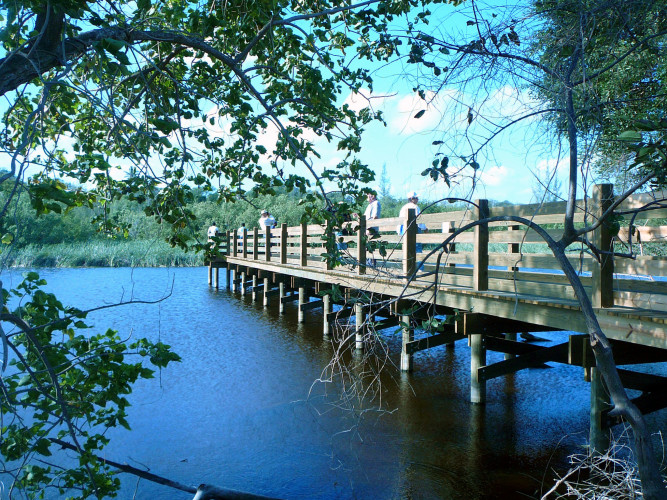New Providence
For such a small island, New Providence supports the second-most Bahamian as well as Caribbean specialty birds after Abaco. It is cruise ship friendly with plenty of amenities, hotels, golf courses and gardens. Many of the sites are accessible only by vehicle, so consider engaging a birding guide, or use A Birder’s Guide to the Bahama Islands by Anthony White and rent a self-drive vehicle. Be advised that this book was published in 1998 and since then the road system around the town has been changed. Some of the sites on New Providence are difficult to locate.
The Bahama Woodstar is the only endemic present on this island and is usually easy to find. New Providence is the only island in the Bahamas where the Cuban Grassquit is found, an introduced Cuban endemic. This bird feeds happily from seed feeders, which is a good place to find it. Also on New Providence is the Caribbean Dove, introduced from Jamaica.

Botanic Gardens in Nassau
Western side of Nassau, on Chippingham Road, south of West Bay Street and near Ardastra Gardens and Conservation Centre. Once a rock quarry, the Botanic Garden is now an 18 acre, cultivated garden with trails, terraces and stonework. To find the most birds, explore the entire garden for the Bahama Woodstar, Loggerhead Kingbird, Cuban Pewee, La Sagra’s Flycatcher, Thick-billed Vireo, Bahama Mockingbird, Red-legged Thrush, Western Spinadalis, Bananaquit, Black-faced and Cuban Grassquits and many migrating and wintering warblers in fall through early spring. Sulphur-crested Cockatoos are often seen here in the high trees, attracted to the area by captive parrots, macaws and cockatoos close by at Ardastra Gardens.
The Retreat Gardens National Park
The Retreat Gardens, headquarters of the Bahamas National Trust, is on Village Road opposite Queens College. Village Road is at the east end of the one-way traffic flow through the town and can be accessed by public bus. Cost: $2. Hours: Open 9 am – 5 pm on weekdays, closed on weekends. Trail maps are available for self-guided tours. Known in botanical circles for its extensive palm collection, this garden also attracts numerous birds.
Look for the Bahama Woodstar, Caribbean Dove, La Sagra’s Flycatcher, Red-legged Thrush, Bahama Mockingbird, Cuban Grassquit, Black-faced Grassquit, Greater Antillean Bullfinch, Western Spindalis, Thick-billed Vireo, Bananaquit. Also in winter are several species of North American warblers, in summer the Black-whiskered Vireo and Gray Kingbird.

Paradise Island
A great birding spot on Paradise Island is the pond on Lakeview Drive. Paradise Island is the island on the north side of Nassau Harbour. To get over to Paradise Island, take a ferry or taxi or walk. No public buses cross the bridge. Ferries run across the harbour from Prince George Wharf about every half hour and is a nice way to get there. By road, cross the toll bridge, turn right, then left at the first roundabout, right at the next junction and follow this past Comfort Suites, then turn left onto Lakeview Drive. Directions are the same from the ferry dock, which is between the two bridges.
On Lakeview Drive, the ponds are visible from the road, with a viewing platform on the west side. The water birds you could see here are the White-cheeked Pintail, Ruddy Duck, Least Grebe, Common Gallinule, Neotropic Cormorant, Wilson’s Snipe, Least Bittern, Sora and a variety of egrets and herons. Also watch for Osprey, Belted Kingfisher, White-crowned Pigeon and, in summer, Gray Kingbird. Land birds include the Red-legged Thrush, Loggerhead Kingbird, Black-faced Grassquit and Bananaquit and winter warblers.
South Westridge Estate
West of Lake Cunningham on the south side of the airport road with access to the north shore of Lake Killarney. Check for shorebirds in winter and terns in the breeding season.
Harrold and Wilson Ponds National Park
At the junction of Sir Milo Butler Highway and Fire Trail Road. Over 100 water and land bird species have been recorded here. Currently there are two boardwalks and observation platforms, with plans to extend the trails round the ponds. Entry is free.

Hobby Horse Lake, Cable Beach
Cable Beach, about 5 miles west of Nassau on the north shore, is on bus route #10. The new ring road around the BahaMar resort has opened up Hobby Horse Lake with two observation platforms. Look for White-cheeked Pintails, Ruddy Ducks, Least and Pied-billed Grebes, Neotropic Cormorants, Least Bitterns, American Coots, Common Gallinules, Sora, herons and wintering migrant ducks. Ospreys are often seen fishing on this pond or perched in the high trees overlooking the pond.

Coral Harbour Road
Pine forest south of the airport offers birding in the early morning. Enter at the gate on the west side of Coral Harbour Road, about half way between the last airport buildings (and the last curve in the road going south) and the Coral Harbour roundabout. Look for Western Spindalis, Cuban Pewee, La Sagra’s Flycatcher, Loggerhead Kingbird, White-crowned Pigeon, Bahama Woodstar, Thick-billed Vireo, the resident Pine Warbler and winter migrants.
For shorebirds at low tide, check out Montagu Foreshore at the east end of the one way traffic system in Nassau and close to the Retreat Gardens. Also try the south east shore of the island between St. Andrew’s Estates and Fox Hill Road and again at South Beach at the south end of East Street and Blue Hill Road.
Bahamian Gift Shop
For the Cuban Grassquit, visit this shop on Shirley Street just east of the traffic light at Fowler Street and Kemp Road, where they keep seed feeders full. They appreciate visits from birders and offer genuine Bahamian arts and crafts so this is a good place to purchase your souvenirs. They also stock laminated bird identification cards.

Blue Shark Golf Club at South Ocean
Obtain permission before entering the golf course. Along the road leading to the golf course parking area, there is still enough undisturbed habitat in the area for the Key West Quail-Dove and several other local species.
Endemics: Bahama Woodstar.
Bahamian specialties: White-cheeked Pintail, Least Grebe, Neotropic Cormorant, Caribbean Dove, Cuban Pewee, La Sagra’s Flycatcher, Loggerhead Kingbird, Smooth-billed Ani, Red-legged Thrush, Thick-billed Vireo, Bananaquit, Western Spindalis, Cuban Grassquit, Black-faced Grassquit, Mangrove Cuckoo, and Greater Antillean Bullfinch. The Key West Quail Dove is extremely hard to find, but sometimes it can be heard. In the summer you can also spot the Gray Kingbird, Black-whiskered Vireo, and Antillean Nighthawk.
